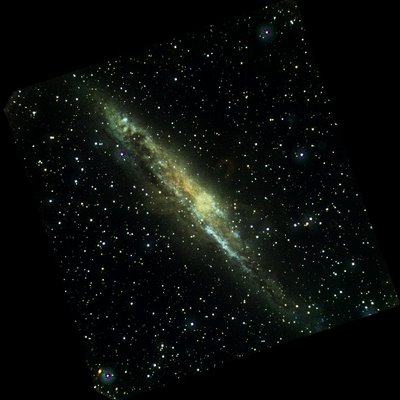
Well, I'm back after a long hiatus due to writing up my XMM-Newton observation of the (supposed) Seyfert 2 galaxy NGC 6810. Various interesting things have happened in the mean time that I mean to post about, both scientific and political, but that will have to wait. In the mean time here is a pretty picture of the very odd galaxy NGC 4945.
As you can see NGC 4945 is a roughly-edge-on spiral galaxy at about 3.7 Mpc distance (~12 million light years), the star-forming spirals arms showing up in blue in this V(isual), B(lue) and U(ultraviolet)-band composite image. Its also rather dusty, with dark or red spots where dust obscuration and reddening is high. I made this image from the Optical Monitor
data from the public XMM-Newton observation.
NGC 4945 is a weird galaxy for a number of reasons. Its one of the 4 brightest extra-galactic infra-red sources in the sky (excluding objects within our Local Group), has a prominent nuclear outflow (e.g. see here, its only ~500 pc [~1500 ly] long), and hosts a very heavily obscured nuclear AGN (i.e. a super-massive black hole weighing somewhere between 1 million and 100 million times the mass of the Sun) that can only be seen at hard X-ray energies (its the brightest source at 100 keV in the sky, if I remember right. At other wavelengths all that dust absorbs the AGN light before it can escape the galaxy). Optically it looks like a starburst, but its hard to work out what fraction of the total emission from the galaxy is starburst-related and what is AGN-related.
All those stars in the image are foreground (i.e. in our Galaxy), and the large number of them tells you (well, tells a professional or amatuer Astronomer anyway) this object is at low galactic latitude (i.e. we're looking through a lot of the Milky Way's disk). This is a pain, as absorption within our Galaxy removes a lot of the soft X-ray emission that could be used to tell us whether NGC 4945
has a galactic-scale wind typical of other starbursts.
All in all, an enigmatic object.





